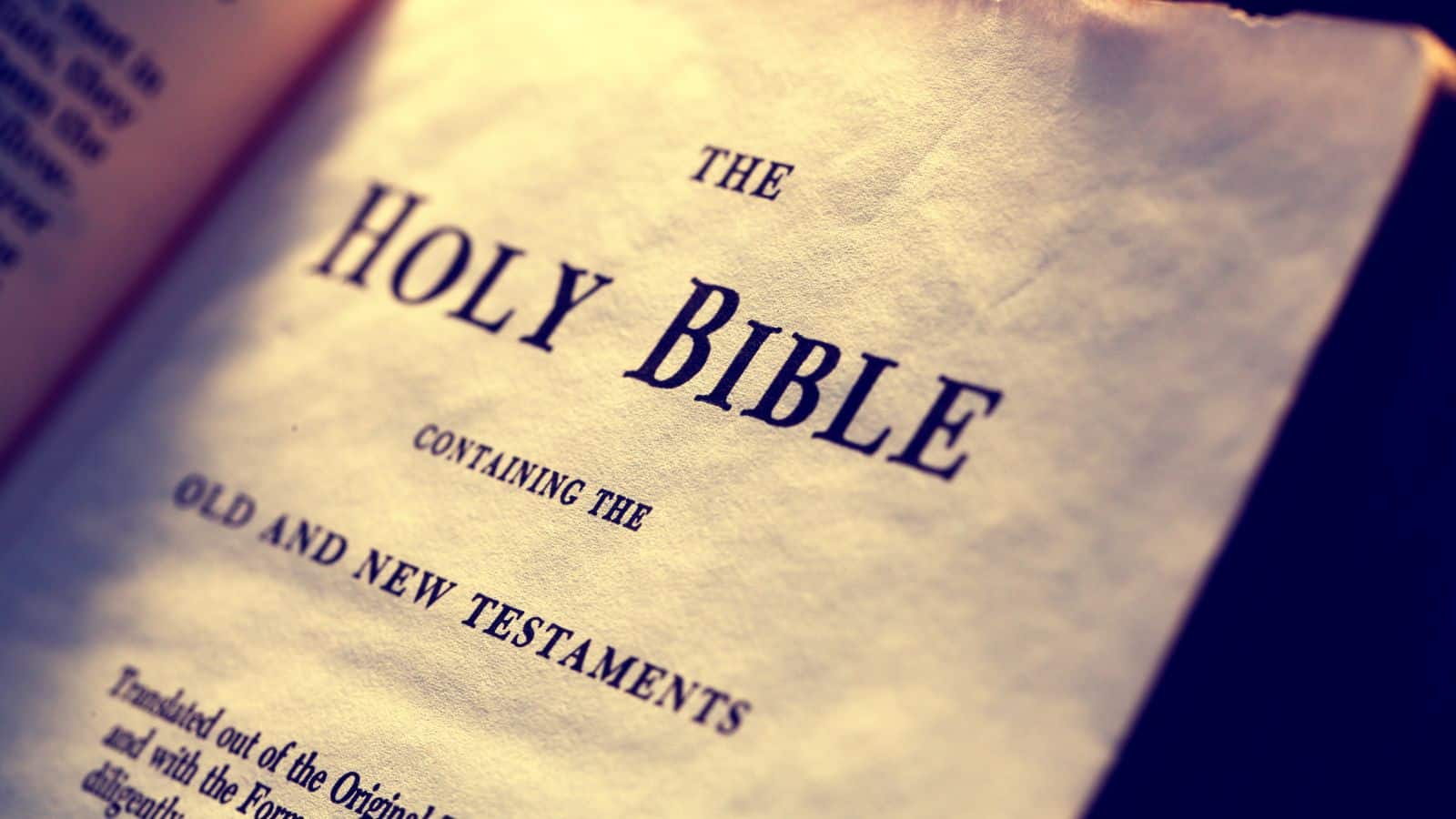The Bible is one of the oldest books in the world, and this means there are many historical facts that come with it. Not only is it one of the oldest books, but it’s also one of the most read. Here are the 17 oldest historical facts about the Bible.
Origins of the Gospels

PBS tells us, “A period of forty years separates the death of Jesus from the writing of the first gospel.” It’s thought that the gospels were developed from oral traditions into written words around 70 AD. This is give or take a few years, as history from this period is sparse.
The Book of Revelation

The Book of Revelation was written around 96 AD, and it’s been thought that it was a response to Roman actions. It also features apocalyptic literature where it’s predicted the end of time. The Book of Revelation was influenced by evangelical interpretation and the popular culture of the time.
Development of the Biblical Canon

History says the Biblical Canon is a document from the 4th century where the Church released guides on how various Biblical texts should be treated. The Muratorian Canon is the oldest of these and is a compilation of texts that resemble the New Testament. These books reflect the historical and religious contexts of the time.
The Gnostic Gospels

These gospels include the discovery of texts from Mary and Thomas. The Gnostic Gospels also feature texts from Judas, which offers the reader controversial insights. These texts are significant when it comes to understanding early Christianity. The Gnostic Gospels were written in 2 AD but weren’t discovered until 1945.
The Bible’s Multilingual Composition

The Bible has been written in many different languages, not just English. It was written in Hebrew, Aramaic, and Greek 1,500 years ago. These contributions have come from many diverse authors, helping people across different contexts understand the Bible. Even though there have been different authors, the message has stayed the same.
The Role of Prophecy in Biblical History

Prophetic books have influenced both the Old and New Testaments of the Bible. Their predictions and their fulfillment have always been a recurring theme and reflect just how much prophecy has shaped the Bible. The New Testament shows Christ as being the supreme prophet.
The Dead Sea Scrolls

According to Britannica, the Dead Sea scrolls were discovered in 1947 and they’re considered the most important finds in modern archeology. They had a huge impact on what we learned about the Bible and can be compared to New Testament manuscripts. They were significant when it came to understanding the reliability of the Bible.
Archeological Discoveries

Finds such as the Moabite Stone and Lachish Letters have helped to support biblical accounts. The Epic of Gilgamesh was also a poem that was discovered in the mid-19th century and has similarities to Noah’s story. Then there was also the discovery of Hezekiah’s tunnel in Israel, which is a water source and links to the Bible.
Eyewitness Accounts in Scripture

There have been claims of direct observation by biblical authors, and this has helped to shape the Bible’s narratives. Most accounts written in the New Testament are thought to be eyewitnesses, which was decided after careful examination of the gospels for first-hand accounts.
The Printing and Distribution of the Bible

Before the invention of the printing press, the only way to distribute the Bible was to copy it by hand, which would have been an incredibly lengthy process. Before the invention of ink and dye, copies would have been engraved onto slabs of rock. It was through these methods that the Bible spread worldwide.
The Bible’s Literary Genres

The Bible is known for consisting of a variety of genres. These include law, history, poetry, prophecy, and epistles. The mixture of all these genres is what contributed to the overall narrative of the Bible. These genres have had a huge impact on religious practices throughout time.
The Bible in the Digital Age

Even though the Bible is one of the oldest books in the world, it still had to be digitized to keep up with modern technology. This means having it in an electronic format, allowing easier accessibility, especially when it comes to studying the book. It shows just how far the book has come, from being engraved on a slab of rock to having access to it on an electronic tablet.
Cultural Influence

The Bible has had a huge cultural influence on the world, from thousands of years ago to modern times. Throughout history, it’s been incorporated into music, art, and writing. For example, one of the most famous works of art is Leonardo Da Vinci’s The Last Supper, which was painted in the 15th century.
Translation History

The Bible has evolved from its original language to global translations in the modern day. For example, Study.com tells us that the first translation of the Bible was in 382 AD, when it was translated into Latin. The translations over time have had a huge impact on the world, allowing everyone to understand and practice Christianity.
Controversies

During the earliest days of the church, there were debates over which books should be included in the Bible. Historical councils were disagreeing over decisions on the canon and this led to many controversies at the time. The decisions that the Church made at this time have had a huge impact on how Christianity has been taught over time.
Bible Manuscripts

So much care and detail were put into the manuscripts for the Bible. For example, Bible.org writes, “The entire scribal process was specified in meticulous detail to minimize the possibility of even the slightest error. The number of letters, words, and lines were counted, and the middle letters of the Pentateuch and the Old Testament were determined.”
Moral Teachings of the Bible

The Ten Commandments were written between the 16th and 13th centuries BC and have become the core moral teaching of the Bible. They’ve had a huge impact on biblical ethics, societal norms, and individual behavior. Even in the modern day, they’re something we still follow.
Read More: 20 Things We Did When We Were Young That We Regret Now

It’s easy to say hindsight is 20/20, but what advice would you really give your younger self? Here are 20 things that most people did when they were young that they regret today.
20 Things We Did When We Were Young That We Regret Now
17 Things That Used to Be Highly Respected But Isn’t Anymore

Many things in the world used to be well-respected before turning into complete jokes for various reasons. An internet survey recently asked people, “What is something that was once highly respected but is now a complete joke?” Here are the top 20 answers:
17 Things That Used to Be Highly Respected But Isn’t Anymore
17 Fairy Tales That Are Now Considered Racist

While fairy tales weave magical narratives that span generations, many emerge from historical and cultural contexts tinged with biases. Hiding in many of these tales, racial undertones can be found. Let’s look at 17 fairy tales that have deeper implications.
17 Fairy Tales That Are Now Considered Racist
17 Things Society Can No Longer Do Because Gen Z Said So

Gen Z, our digital-native, trendsetting generation, is making waves in the cultural sea, steering the ship of societal norms in fresh and unexpected directions. As they charter new territories, there are certain practices they’d rather we say goodbye to. Curious? Let’s take a look at 17 things the rest of us can no longer do because Gen Z said so.
17 Things Society Can No Longer Do Because Gen Z Said So
18 Common Traits Found in Adults Who Had Unhappy Childhoods

Being a parent is a hard job, so even those who are truly trying their best will often miss the mark on creating the best environment for their children. Unfortunately, this means that many of us grow up with far-from-perfect childhoods that affect us into adulthood. Here are 18 common traits found in adults who had unhappy childhoods.

